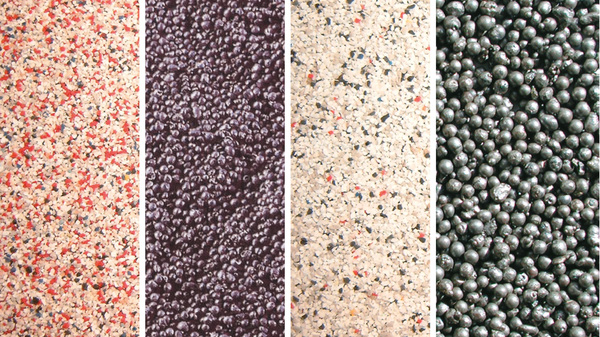Types of abrasive - different grain sizes and variants
In most cases, cast steel in various grain sizes and variants is used as abrasive for compressed air and shot blast plants. Wire grit, i.e. angular or rounded wire sections, is also used.
With round abrasives, the grain size can vary between approx. half a millimetre and three millimetres. A basic distinction is made between high-carbon abrasive - i.e. material with a higher carbon content - and low-carbon abrasive.
A rule of thumb says that high-carbon abrasive breaks faster and is therefore discharged more quickly from the blasting process. However, the sharper-edged abrasive due to the breakage also causes greater blasting effects.
Low-carbon abrasive has a longer service life, so it remains in the blasting process for longer and needs to be refilled less frequently. The abrasive effect is somewhat lower.
Practical experience usually shows which abrasive is better for which application. Because everything depends on which result is defined as the "right" surface.
With compressed air blasting, the variance in abrasives tends to be greater than with wheel blasting. Due to the lower energy used, various mineral abrasives such as corundum are also used. Walnut shells and plastic abrasives are also used. They would immediately turn to dust in a wheel blast machine.
The choice of abrasive always depends on the blasting target, the material of the workpieces and the design of the machine. Only sand, from which the name "sandblasting" originates, is no longer used. This is because quartz crystals are released when the grain is destroyed. These have been identified as a cause of cancer.
Other factors that influence the blasting process
The result of the blasting process depends on many factors. In wheel blasting, the rotational speed of the blast wheel is one of the decisive factors. This can be regulated in stages. However, many customers use frequency-controlled turbines. This allows the speed and therefore the ejection speed to be controlled continuously. This means that many different workpieces can be blasted.
The diameter of the blast wheel also has an influence. The larger it is, the higher the acceleration of the abrasive.
The distance between the turbines and the workpiece also influences the intensity of the blasting process. The smaller the distance, the greater the effect. However, the area on the workpiece directly hit by the abrasive is also reduced.

